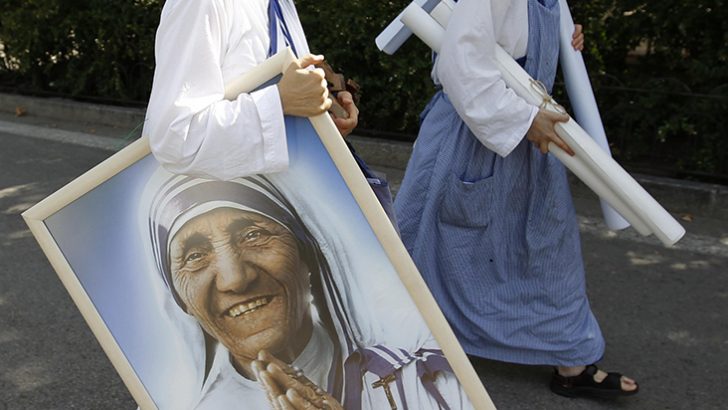A strict religious life that is highly regimented does not fit well with modern tastes, writes David Quinn
‘Was Mother Teresa a cult leader?’, ran the headline in The New York Times last week, and with that began yet another attack on the Catholic saint.
St Teresa of Kolkata, as she is now known within the Church since her canonisation in 2016 by Pope Francis, is probably the outstanding example of holiness in the 20th Century for hundreds of millions of Catholics, and countless other people who were attracted to her work in helping ‘the poorest of the poor’.
Holiness
But this also makes her a very inviting target. If a certain, popular Catholic vision of holiness can be badly undermined, then another major edifice of Catholicism collapses.
The biggest and most famous attack was launched by Christopher Hitchens, the late journalist, in a documentary called Hell’s Angel, in which he accused her of harming the poor by glorifying poverty and suffering and attacked her for accepting money for her work from dictators.
Ms Goldberg presents the congregation, based on the interviews, as a kind of prison, which allowed for no privacy”
The latest attack stems from a series of interviews conducted with former members of the religious order she founded, the Missionaries of Charity.
A writer for The New York Times, Michelle Goldberg, then cherry-picked the worst accusations from those interviews which was then reprinted in The Irish Times.
Ms Goldberg presents the congregation, based on the interviews, as a kind of prison, which allowed for no privacy. Even when you went out on the street, another member of the order was always with you.
There was an extreme commitment to poverty and chastity (you even had to avoid touching other people if you could).
“The Missionaries of Charity, very much, in so many ways, carried the characteristics of those groups that we easily recognise as cults”, said one former member.
There were reports of filthy conditions in hospitals and also children tied to beds.
But when you read the actually interviews on which The New York Times article is based, you find something far more nuanced and balanced. Yes, there are criticisms, but there is also an abiding admiration for Mother Teresa and the work she did.
Even the remark about the order being cult-like is in the manner of an almost throw-away, casual comment, rather than a major, central thesis. The former members of the order do not come across as embittered by their experience or overly hostile to the Missionaries of Charity.
Cults prey on the vulnerable, sometimes enticing them in with a vision of an easy life, and then make it hard to leave”
What comes across to me is that these women decided in the end that the tough life of the order was no longer for them, and it was tough. It probably still is, in many respects.
Mother Teresa believed her fellow nuns had to live exactly like the poor, right down to hand-washing their own clothes (a practice since abolished as too time consuming). The vow of poverty was taken to an extreme or, if you prefer, it was very radical.
The interpretation of the vow of chastity by Mother Teresa was, to my mind, too extreme, but on its own this doesn’t tarnish her reputation or take away from her holiness.
A strict religious life that is highly regimented does not fit well with modern tastes, which prefers lots of personal freedom and therefore thinks commitments should be easy to set aside.
But the idea that the Missionaries of Charity was like a ‘cult’ because of its strict rules and charismatic founder collapses on first contact with the facts. Cults prey on the vulnerable, sometimes enticing them in with a vision of an easy life, and then make it hard to leave.
But anyone wishing to join the Missionaries of Charity had a six-month discernment period to go through first, which was arduous, and deterred many aspirants. One of the women who was interviewed joined in New York in the late 1970s with a total of eight young women, and six left before the six month ‘aspirancy’ period was over. A cult would do everything to anyone who joins.
In addition, anyone who wished to leave even after they took their final vows, was free to do so, as the women interviewed did.
Missionary of Charity
The fact is that the life of a Missionary of Charity is extremely demanding, which is why most people admire them.
On the other hand, many who are members of the order are themselves from very poor backgrounds, so the life might not seem so tough to them especially when they have a bed to sleep in every night, and regular food.
What about the accusations that the hospital in Kolkata was “filthy”? One volunteer who worked in it in the 1980s said it was no more the case than the average Indian hospital.
The former volunteer (Thomas Williams) said: “The poor could rarely get into any hospital. Mother Teresa tried to accept all but even her facilities were overwhelmed, one reason I volunteered there. At this time in India lepers and other seriously ill people lived on sidewalks all over the city. Key medicines were scarce.”
This also helps to explain why children were sometimes tied to beds. When the hospital was overwhelmed, and they couldn’t be watched, a small child could easily wander away and get into trouble.
I suspect a lot of the attacks on Mother Teresa are motivated by the fact that she was an outspoken opponent of abortion and artificial contraception. Like the strict religious life she practiced and advocated, this seems outlandish, and even inhuman, to some people.
But even Mahatma Gandhi was opposed to artificial birth control because he suspected it would undermine sexual morals. It is, of course, self-evident that abortion does the ultimate form of harm to the most vulnerable.
The bottom line is that the world is incontestably better for having had Mother Teresa in it. It is why she is still admired and loved in Kolkata to this day, including by most Hindus, and was given the highest awards the Indian Government had to offer while she was alive. Try as they might, her detractors will never be quite able to topple her.


 David Quinn
David Quinn A member of the
Missionaries of Charity carries a portrait of St Teresa of Kolkata in Madrid’s Buen Retiro park. Photo: CNS
A member of the
Missionaries of Charity carries a portrait of St Teresa of Kolkata in Madrid’s Buen Retiro park. Photo: CNS 